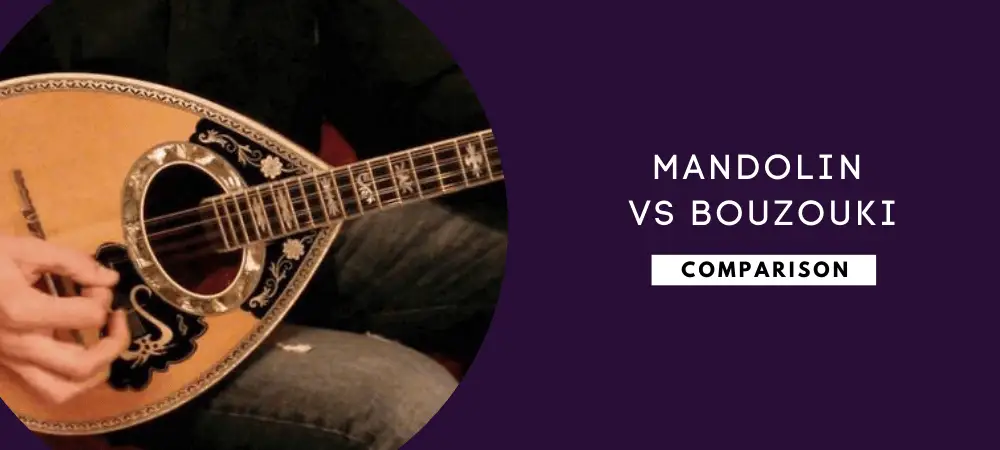Mandolins and bouzoukis look similar in many aspects, including their shape and playing technique.
So, what is it that distinguishes them as two separate musical instruments?
Let’s compare and contrast, and you’ll find that the two instruments are quite different from each other, especially when it comes to their size, strings, octaves, and sound.
Table of Contents
Table of Comparison Between Mandolin and Bouzouki
| Mandolin | Bouzouki | |
| No. of Strings | 8 | 6 or 8 |
| String Material | Steel | Steel |
| Scale Length | 14-Inch Scale | 25-Inch Scale |
| Body Shape | Flat or Rounded Body | Rounded Body |
| Playing Technique | Plucked | Plucked |
| Size | Shorter | Longer |
| Tuning | Tuned To GDAE | Tuned To DAD or CFAD |
| Sound | High Pitched | Deeper Pitch |
| Learning Curve | Easier to Learn | Harder to Learn |
| Price | Less Expensive | More Expensive |
| Origin | Naples, 18th Century | Greece, the Early 1900s |
What Are the Similarities Between Mandolin and Bouzouki?
- Both the mandolin and bouzouki are stringed instruments that are distant descendants of the lute.
- Both instruments have a rounded, bowl-shaped wood body, but some mandolins have a flat, streamlined back instead.
- Both the mandolin and bouzouki have fretted fingerboards.
- Both instruments have hard steel strings, played by plucking.
- The steel strings are set in courses on both instruments. This means that the strings are set and tuned in pairs, as opposed to having single strings.
What Are the Differences Between Mandolin and Bouzouki?
History & Heritage
Mandolins originated from Naples, back in the 18th Century, and this instrument actually evolved from the small soprano lute.
Bouzoukis trace their origin back to Greece in the early 1900s. Having Turkish roots, the bouzouki evolved from the 3-stringed tamboura, an ancient instrument that belonged to the lute family.
The bouzouki is fondly regarded as Greece’s national instrument and is also a beloved instrument among the Irish people.
Body
A mandolin is smaller than a bouzouki and similarly has a shorter neck.
Bouzoukis look very similar to mandolins. However, the one distinction is that the former is distinctly long-necked.
Scale Length & Tuning
Scale length refers to the length of the strings from the nut to the bridge. So essentially, this is the actual part of the strings that vibrates, thereby producing the primary sound.
Mandolins, similar to violins, have a 14-inch scale that’s tuned to G-D-A-E.
Bouzoukis typically have a 25-inch scale, and they are tuned an octave below the mandolin.
The original bouzoukis had the strings set in 3 courses, thereby giving you 6 strings in total. These bouzoukis are referred to as trichord bouzoukis and they are tuned to D-A-D.
Later on, the bouzouki evolved to having 4 courses, thereby having 8 strings in total. This is referred to as the tetrachord bouzouki, and this instrument’s standard tuning is G-D-A-D.
The strings on a bouzouki can either be set up in unison or in octaves.
When set up in unison, the strings are of similar thickness. They sound alike and tend to produce a full sound.
When set up in octaves, the bottom two string pairs, which are the two lower-pitched courses, are set an octave apart.
This means that one string is thicker than the other and is also tuned to an octave lower. However, the upper strings are in unison.
This octave setting is similar to a 12-stringed guitar, and it produces bright tones.
The original Greek bouzouki was tuned to C-F-A-D, whereby the ‘C’ strings would be tuned an octave apart. Some current musicians may opt to tune their bouzoukis this same way, with the high ‘G’ being at the top of the neck.
Playing Technique
While both the bouzouki and the mandolin are playing by plucking, the difference in scale length is the primary reason why both instruments require different playing techniques.
The longer the scale length, the farther apart the frets will be, and as a result, this makes it more challenging to finger tunes on a bouzouki because your fingers will have to stretch farther.
On a mandolin, you have each finger playing two frets.
On a bouzouki, however, each finger only plays a single fret.
Sound & Musical Styles
Both mandolins and bouzoukis produce a sharp metallic sound when plucked. The difference comes in the pitch and tone of either instrument.
Bouzoukis have a noticeably lower pitch than mandolins.
Mandolins have a sweet melodic sound that’s often desired by old-time country, bluegrass, and folk music musicians.
Tetrachord and trichord bouzoukis may have a subtle difference, but this results in two very different instruments regarding how they feel, play, and sound.
Tetrachord bouzoukis have a robust and vibrant sound that’s pretty impressive.
Trichord bouzoukis have a sweet woody tone.
All in all, the bouzouki is an integral part of contemporary Greek culture, playing a significant role in modern Greece music.
Around the world, the bouzouki features in several musical genres, including bluegrass, jazz, rock, and folk music.
Generally, mandolins are better suited for playing tunes, while bouzoukis are more suitable as being accompaniments.
Cost
One other thing that bouzoukis and mandolins have in common is that the cost of either instrument can vary considerably, from $100 to over $10,000.
Regardless, bouzoukis tend to be slightly more expensive than mandolins. An average mandolin with a decent tone will set you back about $300, while the minimum you can pay for a good quality bouzouki is about $400.
That being said, there are many factors that influence the pricing of either instrument. These factors may include the instrument’s design, size, construction, tone woods used, etc.
You generally get what you pay for and expect to pay astronomically more for a custom-made instrument.
Which One Is Easier to Play: Mandolin or Bouzouki?
It is easier to play the mandolin than it is to play the bouzouki.
Bouzoukis have a longer scale, and as a result, the frets are spaced farther apart. This means that the player has to stretch their fingers to reach further, which is where the major challenge comes in when playing the bouzouki.
Despite it being hard to press down on a mandolin string, mandolins are easier to play than a bouzouki because the former has a shorter neck and frets located closer together.
Bouzoukis may be a bit challenging to play, but they are not an overly difficult instrument.
As long as you enjoy playing the instrument and are dedicated to learning it, you will get the hang of it and will be plucking it effortlessly in no time.
FAQs about Mandolin vs Bouzouki
What’s the Difference Between Irish and Greek Bouzouki?
The Irish bouzouki evolved from the Greek bouzouki around 1960.
While the Greek bouzouki has a rounded back, the Irish bouzouki is flatter and also has a shorter neck. These seemingly trivial differences make the Irish bouzouki easier to hold and likewise easier to play than its Greek counterpart.
The shorter neck provides a shorter scale length, which affects the sound produced such that the two instruments do not sound similar to each other. Irish bouzoukis have a brighter sound that’s noticeably more open than what you get from a Greek bouzouki.
As well, the two instruments are traditionally tuned differently, which further explains the difference in sound produced by both instruments.
Does a Bouzouki Sound Like a Mandolin?
No, it does not.
Both instruments produce a sharp metallic sound when plucked. However, the sound from a bouzouki has a lower pitch than that from a mandolin.
Depending on the tone wood used in constructing the soundboard, the tone of a bouzouki could either be bright or deep.
You could alter the brightness of the tone of a bouzouki by adjusting the strings, bridge, or the nut.
A bouzouki has dynamic notes, which is what makes it an ideal instrument for accompaniments, while the mandolin is better-suited for playing tunes.
Conclusion
They might look similar, but the mandolin and bouzouki sound nothing alike, and neither are they the same size either.
Their mandolin lends itself to fast melodies, while the bouzouki’s distinctive sound renders it better suited for accompanying the harp, guitar, or piano.




